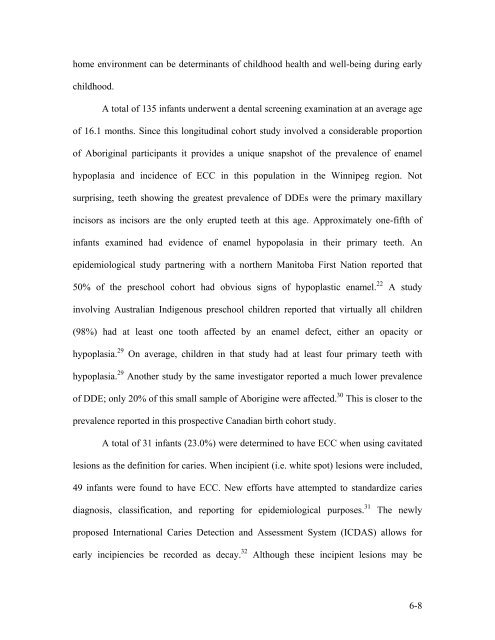Influence of Maternal Prenatal Vitamin D Status on Infant Oral Health
Influence of Maternal Prenatal Vitamin D Status on Infant Oral Health
Influence of Maternal Prenatal Vitamin D Status on Infant Oral Health
Create successful ePaper yourself
Turn your PDF publications into a flip-book with our unique Google optimized e-Paper software.
home envir<strong>on</strong>ment can be determinants <str<strong>on</strong>g>of</str<strong>on</strong>g> childhood health and well-being during early<br />
childhood.<br />
A total <str<strong>on</strong>g>of</str<strong>on</strong>g> 135 infants underwent a dental screening examinati<strong>on</strong> at an average age<br />
<str<strong>on</strong>g>of</str<strong>on</strong>g> 16.1 m<strong>on</strong>ths. Since this l<strong>on</strong>gitudinal cohort study involved a c<strong>on</strong>siderable proporti<strong>on</strong><br />
<str<strong>on</strong>g>of</str<strong>on</strong>g> Aboriginal participants it provides a unique snapshot <str<strong>on</strong>g>of</str<strong>on</strong>g> the prevalence <str<strong>on</strong>g>of</str<strong>on</strong>g> enamel<br />
hypoplasia and incidence <str<strong>on</strong>g>of</str<strong>on</strong>g> ECC in this populati<strong>on</strong> in the Winnipeg regi<strong>on</strong>. Not<br />
surprising, teeth showing the greatest prevalence <str<strong>on</strong>g>of</str<strong>on</strong>g> DDEs were the primary maxillary<br />
incisors as incisors are the <strong>on</strong>ly erupted teeth at this age. Approximately <strong>on</strong>e-fifth <str<strong>on</strong>g>of</str<strong>on</strong>g><br />
infants examined had evidence <str<strong>on</strong>g>of</str<strong>on</strong>g> enamel hypopolasia in their primary teeth. An<br />
epidemiological study partnering with a northern Manitoba First Nati<strong>on</strong> reported that<br />
50% <str<strong>on</strong>g>of</str<strong>on</strong>g> the preschool cohort had obvious signs <str<strong>on</strong>g>of</str<strong>on</strong>g> hypoplastic enamel. 22 A study<br />
involving Australian Indigenous preschool children reported that virtually all children<br />
(98%) had at least <strong>on</strong>e tooth affected by an enamel defect, either an opacity or<br />
hypoplasia. 29 On average, children in that study had at least four primary teeth with<br />
hypoplasia. 29 Another study by the same investigator reported a much lower prevalence<br />
<str<strong>on</strong>g>of</str<strong>on</strong>g> DDE; <strong>on</strong>ly 20% <str<strong>on</strong>g>of</str<strong>on</strong>g> this small sample <str<strong>on</strong>g>of</str<strong>on</strong>g> Aborigine were affected. 30 This is closer to the<br />
prevalence reported in this prospective Canadian birth cohort study.<br />
A total <str<strong>on</strong>g>of</str<strong>on</strong>g> 31 infants (23.0%) were determined to have ECC when using cavitated<br />
lesi<strong>on</strong>s as the definiti<strong>on</strong> for caries. When incipient (i.e. white spot) lesi<strong>on</strong>s were included,<br />
49 infants were found to have ECC. New efforts have attempted to standardize caries<br />
diagnosis, classificati<strong>on</strong>, and reporting for epidemiological purposes. 31<br />
The newly<br />
proposed Internati<strong>on</strong>al Caries Detecti<strong>on</strong> and Assessment System (ICDAS) allows for<br />
early incipiencies be recorded as decay. 32<br />
Although these incipient lesi<strong>on</strong>s may be<br />
6-8







![an unusual bacterial isolate from in partial fulf]lment for the ... - MSpace](https://img.yumpu.com/21942008/1/190x245/an-unusual-bacterial-isolate-from-in-partial-fulflment-for-the-mspace.jpg?quality=85)





![in partial fulfil]ment of the - MSpace - University of Manitoba](https://img.yumpu.com/21941988/1/190x245/in-partial-fulfilment-of-the-mspace-university-of-manitoba.jpg?quality=85)


